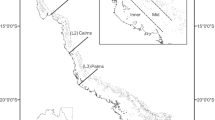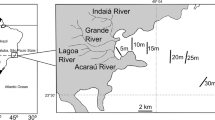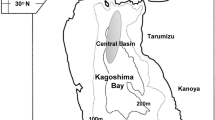Abstract
The population dynamics of the stout razor clam,Tagelus plebeius, were investigated for three years. Density, year-class structure, and recruitment varied with elevation above mean low water, among sample areas, and among years. Recruitment was unimodel and restricted to the late spring. Over 80% of the juveniles recruited in the spring were absent from the sample areas by the following fall. Growth rates ofT. plebeius varied with season, age, and elevation above MLW, but did not vary among sample areas or years.T. plebeius grew faster and reached a larger final length in low intertidal areas. The American Oystercatcher,Haematopus palliatus palliatus, and the stingrays,Dasyatis sabena andDasyatis americana, were the major clam predators identified.
Similar content being viewed by others
References
Ansell, A. D. 1961. Reproduction, growth, and mortality ofVenus striatula (Da Costa) in Kames Bay, Millport.J. Mar. Biol. Asso U.K. 42:191–215.
Bayne, B. L. 1965. Growth and delay of metamorphosis of the larvae ofMytilus edulis.Ophelia 2:1–47.
Burke, M. W., andK. H. Mann. 1974. Productivity and production: biomass ratios of bivalve and gastropod populations in an eastern Canada estuary.J. Fish. Res. Bd. Canada 31:167–177.
Connell, J. H. 1961a. The influence of interspecific competition and other factors on the barnacleChthamalus stellatus.Ecology 42:710–723.
— 1961b. Effects of competition, predation byThais lapellus, and other factors on natural populations of the barnacleBalanus balanoides.Ecol. Monogr. 31:61–104.
Crisp, D. J. 1971. Energy flow measurements, p. 197–280.In N. A. Holme and A. D. McIntyre (eds.) Methods for the study of marine benthos. Blackwell Scientific Publications. Oxford and Edinburgh, UK.
Chanley, P., andM. Castagna. 1971. Larval development of the stout razor clam,Tagelus plebeius Solander (Solecurtidae: Bivalvia).Chesapeake Sci. 12:167–172.
Dame, R. F. 1972. The ecological energetics of growth, respiration, and assimilation in the intertidal American Oyster,Crassostrea virginica.Mar. Biol. 17:243–250.
Dehnel, P. A. 1955. Rates of growth of gastropods as a function of latitude.Physiol. Zool. 28:115–144.
— 1956. Growth rates in latitudinally and vertically separated populations ofMytilus californianus.Biol. Bull. Woods Hole 110:43–53.
Dexter, D. M. 1971. Life history of the sandybeach amphipodNeohaustorius schmitzi (Crustacea: Haustoriidae).Mar. Biol. 8:232–237.
Fraser, T. N. 1967. Contributions to the biology ofTagelus divisus (Tellinacea: Pelecypoda) in Biscayne Bay, Florida.Bull. Mar. Sci. 17:111–132.
Frey, R. W. 1968. The lebensspuren of some common marine invertebrates near Beaufort, North Carolina. I. Pelecypod burrows.J. Paleontol. 42:570–574.
Green, R. H., andK. D. Hobson 1970. Spatial and temporal structure in a temperature intertidal community, with special emphasis onGemma gemma (Pelecypoda: Mollusca).Ecology 51:999–1011.
Holland, A. F., andJ. M. Dean. 1977. The biology of the stout razor clamTagelus plebeius. I. Animalsediment relations, feeding mechanism, and community biology.Chesapeake Sci. 18(1):58–66.
—, andC. E. Sansbury. 1973. A study of the annual salinity and temperature regime of the North Inlet estuary.Bull. S. C. Acad. Sci. 35:129.
Howard, J. D., andJ. Dörjes. 1972. Animal-sediment relationships in two beach-related tidal flats; Sapelo Island, Georgia.J. Sed. Petrol. 42:608–623.
Hughes, R. N. 1970. Population dynamics of the bivalve,Scrobicularia plana (Da Costa) on an intertidal mud flat in North Wales.J. Anim. Ecol. 39:333–356.
Lammens, J. J. 1967. Growth and reproduction in a tidal flat population ofMacoma balthica (L.).Neth. J. Sea Res. 3:315–382.
Matthiessen, G. C. 1960. Intertidal zonation in populations ofMya arenaria.Limnol. Oceanogr. 5:381–388.
Orton, J. H. 1928. On rhythmic periods in shell-growth inOstrea edulis with a note on fattening.J. Mar. Biol. Asso. U.K. 15:365–427.
Shaw, W. N. 1965. Seasonal setting patterns of five species of bivalves in Tred Avon river, Maryland.Chesapeake Sci. 6:33–37.
Sparks, A. K., andK. K. Chew. 1966. Gros infestation of the littleneck clam (Venerupis staminea) with a larval cestode (Echeneibothrium sp.).J. Invert. Path. 8:413–416.
Author information
Authors and Affiliations
Additional information
This work was supported by the Belle W. Baruch Foundation and is Contribution No. 118 of the Belle W. Baruch Institute for Marine Biology and Coastal Research.
Rights and permissions
About this article
Cite this article
Holland, A.F., Dean, J.M. The biology of the stout razor clamTagelus plebeius: II. Some aspects of the population dynamics. Chesapeake Science 18, 188–196 (1977). https://doi.org/10.2307/1350860
Issue Date:
DOI: https://doi.org/10.2307/1350860




